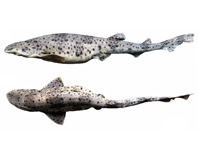Abstract
The final stadium larvae of Onychogomphus castor Lieftinck and O. duaricus Fraser are described and illustrated for the first time based on reared specimens from Thailand. The taxonomic characteristics of the larvae of the genus Onychogomphus are discussed and summarized. The larva of O. castor differs from other Southeast Asian species in having distinct mid-dorsal spines on S2–9, divergent wing pads reaching S5, and lateral spines on S6–9. The larva of O. duaricus has a weakly swollen third antennal segment, with short blunt mid-dorsal spines on S2–9, divergent wing sheaths reaching the middle of S4, and lateral spines present on S7–9.
References
Asahina, S. (1986) A list of the Odonata recorded from Thailand, Part XIV. Gomphidae 2. Tombo, 29 (1–2), 7–53.
Butler, S.G. (2004) Description of the last instar larva of Onychogomphus aequistylus Selys, 1892 (Anisoptera: Gomphidae). Odonatologica, 33 (2), 189–194.
Dumont, H.J., Haritonov, A.Y. & Borisov, S.N. (1992) Larval morphology and range of three West Asiatic species of genus Onychogomphus Selys, 1854 (Insecta: Odonata). Hydrobiologia, 245, 169–177.
http://dx.doi.org/10.1007/BF00006158Novelo-Gutiérrez, R. & Che Salmah, M.R. (2013) Two interesting larvae of Onychogomphus from Malaysia (Anisoptera: Gomphidae). Odonatologica, 42 (1),
31–38.
Schorr, M. & Paulson, D. (2015) World Odonata List. Available from: http://www.pugetsound.edu/academics/academic-resources/slater-museum/biodiversity-resources/dragonflies/world-odonata-list2/ (accessed 22 October 2015)
Watson, M.C. (1956) The utilization of mandibular armature in taxonomic studies of anisopterous nymphs. Transactions of the American Entomological Society, 81, 155–202.

